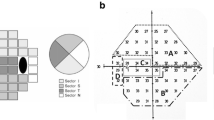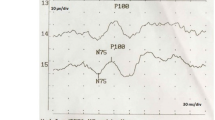Abstract
Background
The prevalence of primary open-angle glaucoma (POAG) increases in obstructive sleep apnea syndrome (OSAS). OSAS could increase cerebrospinal fluid pressure (CSFP) and binocular papilledema.
Methods
In this cross-sectional study, intraocular pressure (IOP), CSFP, mean deviation (MD), pattern standard deviation (PSD), optic disc indices, and retinal nerve fiber layer (RNFL) were compared among four groups with different extents of OSAS. Regression analysis was performed to correlate MD, PSD, and RNFL to polysomnography (PSG) index. For subgroups with severe OSAS, IOP and CSFP were compared. The prevalence of POAG was calculated.
Results
The severe OSAS had a significantly higher CSFP than the other three groups (p = 0.002, 0.036, and 0.017). Both moderate and severe groups showed significantly higher IOP than control group (p = 0.022 and 0.001). MD was correlated with average oxygen saturation (MSaO2) (p = 0.001). PSD was correlated with oxygen desaturation index (ODI) (p = 0.004). Significant differences were found in nasal RNFL and inferior RNFL among the four groups (p = 0.013, p = 0.004). Nasal RNFL correlated with the ODI (p = 0.048). For severe group, compared to normal RNFL group, CSFP was significantly lower in the thinned RNFL group (p = 0.039) and higher in the thickened RNFL group (p = 0.034). Totally, the prevalence of POAG was 5.49 %.
Conclusions
OSAS had a high prevalence of POAG. Visual field was damaged and the RNFL was thinned. Due to diverse CSFP, RNFL changed differently in the patients with severe OSAS.
Similar content being viewed by others
References
Fletcher EC (2003) Sympathetic overactivity in the etiology of hypertension of obstructive sleep apnea. Sleep 26:15–19
Kato M, Roberts-Thomson P, Phillips BG, Haynes WG, Winnicki M et al (2000) Impairment of endothelium-dependent vasodilation of resistance vessels in patients with obstructive sleep apnea. Circulation 102:2607–2610
Priou P, Gagnadoux F, Tesse A et al (2010) Endothelial dysfunction and circulating microparticles from patients with obstructive sleep apnea. Am J Pathol 177:974–983
Parish JM, Somers VK (2004) Obstructive sleep apnea and cardiovascular disease. Mayo Clin Proc 79:1036–1046
Lattimore JD, Celermajer DS, Wilcox I (2003) Obstructive sleep apnea and cardiovascular disease. J Am Coll Cardiol 41:1429–1437
Yaggi HK, Concato J, Kernan WN, Lichtman JH, Brass LM, Mohsenin V (2005) Obstructive sleep apnea as a risk factor for stroke and death. N Engl J Med 353:2034–2041
McNab AA (1997) Floppy eyelid syndrome and obstructive sleep apnea. Ophthal Plast Reconstr Surg 13:98–114
McNab AA (2005) The eye and sleep. Clin Exp Ophthalmol 33:117–125
Mojon DS, Goldblum D, Fleischhauer J et al (1999) Eyelid, conjunctival, and corneal findings in sleep apnea syndrome. Ophthalmology 106:1182–1185
Mojon DS, Hedges TR III, Ehrenberg B et al (2002) Association between sleep apnea syndrome and nonarteritic anterior ischemic optic neuropathy. Arch Ophthalmol 120:601–605
Bendel RE, Kaplan J, Heckman M, Fredrickson PA, Lin SC (2008) Prevalence of glaucoma in patients with obstructive sleep apnoea—a cross-sectional case series. Eye 22:1105–1109
Lin PW, Friedman M, Lin HC, Chang HW, Wilson M et al (2011) Normal tension glaucoma in patients with obstructive sleep apnea/hypopnea syndrome. J Glaucoma 20:553–558
Bucci FA, Krohel GB (1986) Optic nerve swelling secondary to the obstructive sleep apnea syndrome. Am J Ophthalmol 105:428–430
Lee AG, Golnik K, Kardon R, Wall M, Eggenberger E, Yedavally S (2002) Sleep apnea and intracranial hypertension in men. Ophthalmology 109:482–485
Iber C, Ancoli-Israel S, Chesson AL Jr, Quan SF (2007) The AASM manual for the scoring of sleep and associated events: rules, terminology and technical specifications. American Academy of Sleep Medicine, Westchester
Xie X, Zhang X, Fu J et al (2013) Intracranial pressure estimation by orbital subarachnoid space measurement. Crit Care 17:R162
Karakucuk S, Goktas S, Aksu M et al (2008) Ocular blood flow in patients with obstructive sleep apnea syndrome (OSAS). Graefes Arch Clin Exp Ophthalmol 246:129–134
Geyer O, Cohen N, Segev E et al (2003) The prevalence of glaucoma in patients with sleep apnea syndrome: same as in the general population. Am J Ophthalmol 136:1093–1096
Girkin CA, McGwin G Jr, McNeal SF, Owsley C (2006) Is there an association between pre-existing sleep apnoea and the development of glaucoma? Br J Ophthalmol 90:679–681
Liang YB, Friedman DS, Zhou Q, Handan Eye Study Group et al (2011) Prevalence of primary open angle glaucoma in a rural adult Chinese population: the Handan eye study. Invest Ophthalmol Vis Sci 52:8250–8257
Moghimi S, Ahmadraji A, Sotoodeh H et al (2013) Retinal nerve fiber thickness is reduced in sleep apnea syndrome. Sleep Med 14:53–57
Tsang CS, Chong SL, Ho CK, Li MF (2006) Moderate to severe obstructive sleep apnoea patients is associated with a higher incidence of visual field defect. Eye (Lond) 20:38–42
Casas P, Ascaso FJ, Vicente E et al (2013) Retinal and optic nerve evaluation by optical coherence tomography in adults with obstructive sleep apnea-hypopnea syndrome (OSAHS). Graefes Arch Clin Exp Ophthalmol 251:1625–1634
Ren RJ, Jonas JB, Tian GH et al (2010) Cerebrospinal fluid pressure in glaucoma: a prospective study. Ophthalmology 117:259–266
Ren R, Wang N, Zhang X, Tian G, Jonas JB (2012) Cerebrospinal fluid pressure correlated with body mass index. Graefe’s Arch Clin Exp Ophthalmol 250(3):445–446
Berdahl JP, Fleischman D, Zaydlarova J, Stinnett SS, Allingham RR, Fautsch MP (2012) Body mass index has a linear relationship with cerebrospinal fluid pressure. Invest Ophthalmol Vis Sci 53(3):1422–7
Conflicts of interest
No authors have conflict of interest in this study.
Author information
Authors and Affiliations
Corresponding author
Rights and permissions
About this article
Cite this article
Xin, C., Zhang, W., Wang, L. et al. Changes of visual field and optic nerve fiber layer in patients with OSAS. Sleep Breath 19, 129–134 (2015). https://doi.org/10.1007/s11325-014-0978-9
Received:
Revised:
Accepted:
Published:
Issue Date:
DOI: https://doi.org/10.1007/s11325-014-0978-9




